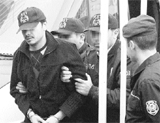‘Drift dive’ on a strong southwester day

Click to read the article in Turkish
You know, it is a public holiday one day before, or the holiday is combined with the weekend, resulting in a longer holiday. Divers use these opportunities to go diving. This is the story you will read, the story of such a long weekend vacation. In this article, we are discussing "What to do in a dive, what not to do and how to solve problems underwater".
I've been talking about this dive for almost twenty years with my diving buddy, my friend and colleague Tamer Durak. While talking about it recently, Tamer said to me, "Let's write it down". Luckily, we wrote it on the same day, he published it before me.
In summary, we describe an instructive memory, how to deal with the current in a risky dive, and how to overcome difficulties in a dive.
There is critical information for divers and those who want to start diving in these two articles. I am describing the same dive from my point of view. After an instructive dive, we talk about our experiences, which should be paid attention to by those who are interested in underwater and sportive diving, and many important issues that a 15–20-minute winter dive teaches us.
Diving on a cold windy day
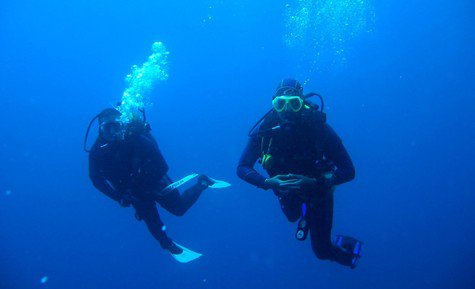
* Photo: Tamer Durak
We all have our own diving gear; the mask-wet-suit-booties trio that we call "abc" has already been purchased, there are regulators that allow us to breathe underwater, saving a little more money and a buoyancy jacket, namely BCs. Since there is very little domestic production, diving equipment is usually imported and sold in foreign currency under all conditions.
But with the money they earned back then, people could buy this equipment, which was sold in exchange for foreign currency, without putting divers in such extreme financial difficulties; nowadays, it is very hard due to the rise in Dollar and Euro against Turkish Lira. Such good days, especially when you look at the current state of exchange rates...
This is the story of a diving tour we went on with my buddy Tamer Durak, who embarked on the path of becoming a diving instructor (instructor) and completed his first advanced course, and two-star divers, Ekrem Özgelen and I. We have all completed the necessary formation to dive together, including night and wreck dives. At that time, there were no current regulations, the legislation allowed diving without the intermediary of a diving school. So, divers can go and dive comfortably in the beautiful parts of the Saroz Gulf as long as they have their diving certificates with them.
Strong weathers, be careful!
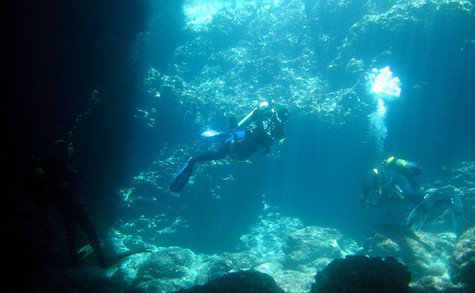
* Photo: Tamer Durak
After doing wall dives in Saroz İbrice Harbor, which our heroes in this story love so much, their plans are to go to Tenedos, namely Bozcaada, and spend two days diving in that magnificent diving area, which they have always heard about and where they have never dived before.
The weather is a "little" bad. Winter is just coming out. There are strange weathers where spring is mixed with your mind, you have to go out with a coat, but when you move a little too much, it gets hot, that's a day like that.
I'm driving the car, I'm not such an experienced driver those days. That's why I keep the steering wheel taut on the road. Right after Mahmutbey toll booths, the strong southwester starts to force the inexperienced driver's steering wheel, blowing hard towards Marmara. Ekrem has already fallen asleep in the back seat. Tamer talks to me so that I don't get sleepy while driving. The radio is on, music is played, a short coffee break, eating a pastry for breakfast, and we continue on our way. Ekrem wakes up every now and then, making jokes in his sleepy state, and we have fun.
Chatter with divers: Non-divers could get bored
When two or more divers get together, they talk almost exclusively about diving. A warning for those who accidentally fall among a diving team and will be exposed to this conversation: If they do not have diving experience, this chat can bore them.
Ekrem was the most diver of all of us in those days. He begins to explain, talking about how he encountered a turtle in Kaş, İbrice "Left 1", or "Hell", where wonderful wall dives are made, saw moray eel, there was also a beautiful Grouper there, maybe we would see it that day too. I'm not going to lie, Ekrem crushes us a little with his experience.
Ekrem had dived "60+" (that is, a little more than sixty) in those days 20 years ago, he sees it appropriate to express it that way. I'm around 30 dives, Tamer has a lot more dives than me.
We're talking about the previous dives we made, when the stories we told turn to hunter-like chatter from time to time, we react like "Come on!", laughter, slurs saying and also "No, you're the king of England ".
Sometimes, when the level of exaggeration increases, slang comes into play, of course, some expressions that come out of the mouth without hesitation, bounce off the roof of a poor quality and rented domestic car and mix with laughter. The winds blowing hard along the way and the heavy downpour make the novice driver tired and sometimes increase his tension.
After a three-and-a-half-hour drive, we arrive at the diver's hotel in Keşan near Saroz Gulf. Empty air tanks are immediately left to the compressor. For a certain price, the air is filled. We are on our way to İbrice.
We're doing two great wall dives. The cove called "Hell" is sheltered from southerly winds, dives finish smoothly without encountering either surface or undercurrent. The water is cold, so dive times are short. But whatever, we're having a lot of fun. There is no trace of the vitality that Ekrem talked about along the way; neither moray nor grouper... There are some little small sea breams, sparrows, lots of priest fish and that's all.
But for the diver, just being under the water and breathing the air coming from the tank creates a feeling of satisfaction on its own.
We have an amateurish spirit (it still is, by the way). After these two dives, we go to the compressor in the hotel again and the air is fresh. Next day, we will go to Bozcaada with the first ferry, and as soon as the tanks are thrown in the trunk, we are on our way to Çanakkale. We will stay there for the night, take the first ferry the next day, Tenedos.
The ferry is moving with the effect of strong wind. After all, it is approaching the pier, albeit with a bit of difficulty. Until late, we have long conversations about the Battle of Gallipoli and engage in discussions of ideas. This long discussion is stealing our sleep, but what a shame.
Southwester spoils plans
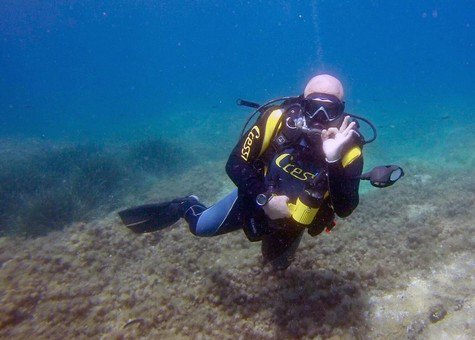
*Photo: Hamdi Uygur
We wake up according to the ferry time, the destination is Geyikli pier, where the ferry will depart. What is this! The wind is getting stronger, the ferry we hope to board is tied to the pier, swaying like a hazelnut shell in the rough waves. It seems impossible for him to move towards the island. As the time of the ferry approaches, the officer's cancellation announcement is heard, and the Tenedos dive they dreamed of is a "lie" for now.
Ekrem is keeping his calm, the dives went well the previous day, it's enough for him. But the young (!) are impatient, the number of dives is insufficient in their own way, they want to increase it. "While we've come this far," says Tamer, "let's go and dive in Gallipoli, Kemikli Bay." The idea sounds good.
We start our short journey with the excitement of getting on the ferry from Çanakkale again, to Eceabat, and then to Kabatepe to taste a new dive site for us. We stand on a slightly overhead view of Küçük Kemikli (Nibrunesi Point), all three of us eyes scanning the surface of the sea.
This place is also partially sheltered from the Southwester at least the inactivity on the water's surface creates such an impression, or rather an illusion. Gökçeada (Imroz) is looking at us from the opposite side.
Tamer and I are starting to prepare for the dive. Ekrem says, "You dive guys, I won't", but he helps us to prepare, he senses what might happen due to the dark clouds that started to accumulate over Gökçeada, probably offshore, and the hardening wind. We will find out later that he is not wrong. We take the materials from the trunk of the car parked at a distance of 15 meters from the sea, on a slightly sloping terrain, and equip ourselves.
What if the current comes from behind?
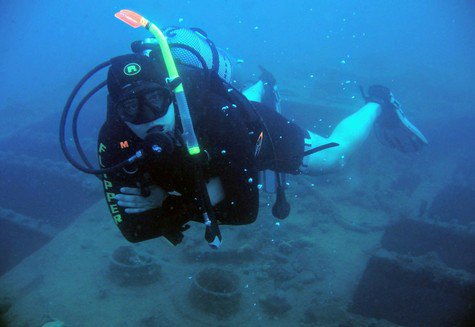
* Photo: Tamer Durak
We are ready to dive. The dive leader is Tamer, who takes firm steps towards being an instructor, being trained to teach how to dive. I'm tired of driving, I can feel it. But I'm going after Tamer. The water is too cold. The ground is rocky. A rocky coastline. So is the water.
We put on the fins, inflate the BCs and head a little open. Indispensable "buddy check" is done. Ekrem is happy with his decision, he doesn't show the slightest hesitation because he's not diving. A slight uneasiness can be felt on his face as he wishes us a good dive, "Oh beware!" says.
The dive begins. We descend under the water with the feeling of an ordinary shore dive for divers who have done quite a few (30+) dives for those days in both summer and winter. As buddies, we give the OK signal to each other at 6 meters, everything is fine. We are flapping fins in a brand-new place where we have never dived before, where we only heard from someone that there were good dives there, and where we do not know the sea floor.
But there is something wrong. The water never gets deeper, we keep wandering at 11 to 13 meters. Always the same depth...
This indicates that there is a problem with direction determination. Tamer makes a "wait" sign to me and emerges from the water. Going up and down with an anxious look in his eyes can easily be read even from behind the mask. Again, with the dive signs, he makes another sign that means "the dive is over, we are going up" to me.
While I try to make sense of what is going on, Tamer begins to rise upwards again. Soon we meet at the surface of the water. What we notice and see is somewhat scary: A strong undercurrent is driving us out of the bay without us even noticing it. We do not feel that we are being dragged, as the current slowly hits us out of the shore to the open water.
What's next then?
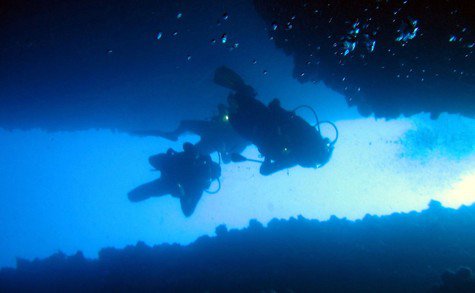
* Photo: Hamdi Uygur
Both of our eyes are wide open. The current is literally pushing us into the open sea. I tell Tamer, "Let's check the compass, determine the direction, stick to the sea floor, and follow the compass to reach the shore by pulling ourselves off the rocks." We learned this in theoretical lessons before, but we are limited to theory only at that moment. In other words, being swept away by such a current was not something that often happened to us those days.
Of course, it turns into a situation that we encounter frequently over the years. After all, we are talking about 20 years ago. However, Tamer makes another decision, as he feels responsible for me and does not encounter such a situation too often. The underwater diving leader is the captain. Whatever he says is done, it is not a subject open to discussion. There is no time to think and discuss for a long time anyway, we are drifting.
In fact, instead of going from the bottom with the compass, Tamer decides to go from the surface towards the rock on his left. Turning on our backs, we reach the shore with difficulty by flapping our fins from the surface of the water, whose flutter and upper current increase with the southwesterly, quite far from where we started our dive. When swimming on your back, leg cramps and resolves, fatigue creates a feeling of almost exhaustion.
Fortunately, we are reaching land. When the strong current reaches the rocks, this time it leaves its place to strong waves. Each wave keeps tossing us both back and forth. Tamer is in front of me, I am behind, we are trying to get ourselves to a safe place. The fins are most important now. The air tank on our back, the weight on the waist... It's tiring, of course.
At this stage, I take the regulator out of my mouth to breathe, and the mask from my face. Tamer is trying to tell me "Don't do that", he can't speak properly because he has the regulator in his mouth, and I don't quite understand what he means, because he never takes off his gear.
When a wave hits me hard and smashes my face lightly against a rock, I understand what it means: Whatever the case, the mask and regulator must remain attached whether you reach the shore or the dive boat in harsh weather and sea conditions. The gear protects you.
Otherwise, an injury may occur, you may hit your face like me, your dive buddy may land a flipper in the face without realizing it. So, I by-pass this accident very cheap and put my equipment back on.
Then Ekrem comes. The expression "What did you guys do, I told you" on his face... It takes the excess off us; the weight belts and fins go to the trunk of the car. We are still trying to climb the rocks and throw ourselves on the beach with Tamer, but we finally succeed.
What to do and what not!
We gain valuable experience by seeing many things that should not be done in diving in a single dive and survived, get off cheap, and we learn a lot:
- Never dive where you don't know the seabed. If you are going to dive without a guide, gather information about it and examine the underwater topography.
- Research prevailing winds and how they can form undercurrents. Current solutions are difficult but there are recipes, learn and try.
- Compass and direction finders as well as all the other equipment must be used effectively.
- While in the water stay without removing your mask from your face till you totally come out to shore or diving boat.
- Pay attention to your rest and sleep patterns.
- Let me add without forgetting: One day before your dive don't drink alcohol.
Of course, know how to stand shoulder to shoulder, from shoulder to shoulder. Just like here, we always earn what we can do, buddy, it's like 20-odd lightning bolts. Oh, of course, follow seniors' advises. I hope Ekrem's ears are burning. (MU/APK/KU/SD)
WE SPEAK WITH ELLEN TORDESILLAS FROM THE PHILIPPINES
Dictator-toppling journalism

52 MEN 52 WEEKS/ 40 MURAT UTKU
The Navy Years, Civilian Life and States of Manhood
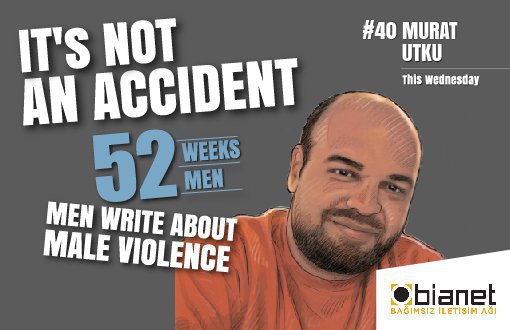
Two “Peace” and “War” Oriented Perspectives on Same TV Footage

Shocking Police Recording in Dink Case
